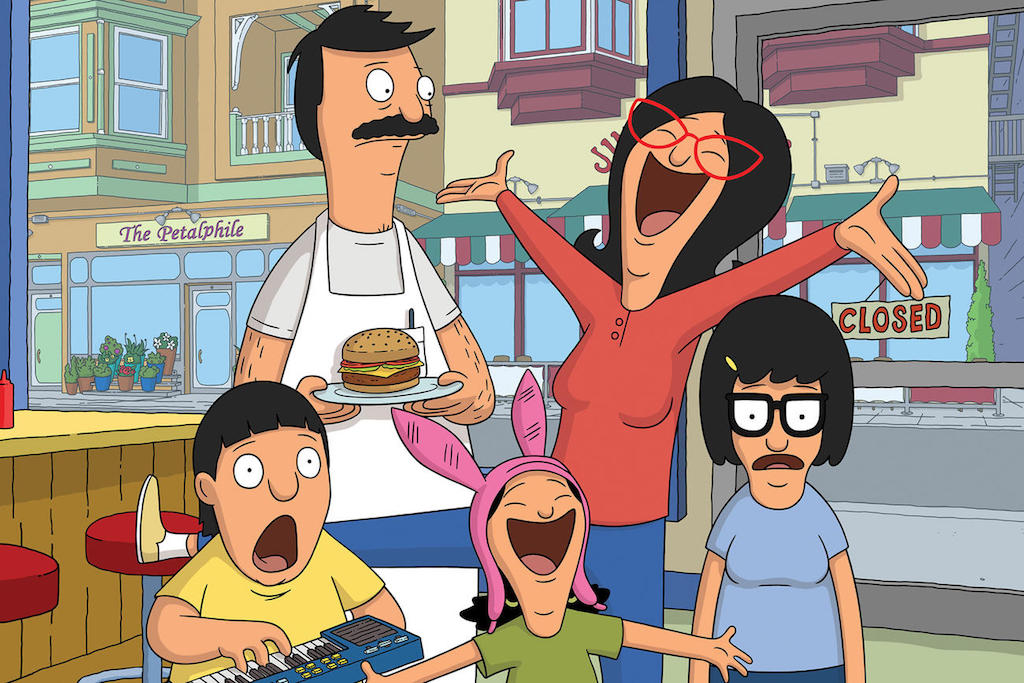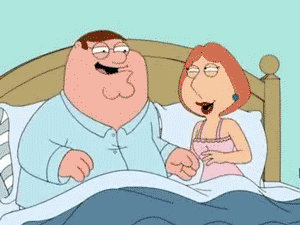Fuck Seth MacFarlane: How I Re-Discovered Good Animated Comedy (That Isn’t All About Dudes)
"I used to tell people 'I don’t really like animated shows'. What a ridiculous thing to say. What I meant was 'I hate Seth MacFarlane'."

Everyone is talking about women in comedy. I don’t remember the last time I read something by an Australian talking about comedy that wasn’t about Women In Comedy. I get it, I do, because women are doing lots of good and funny things and people are still surprised, or angry, or want to play devil’s advocate on the topic, which is obscenely boring and wrong. I’m tired of reading about it — which is saying a lot because I love both women and comedy.
But I just have to say one more thing about it, because people are forgetting about some of the best females in comedy — some of whom aren’t even real people. I gotta talk about animated comedies and the women on the screen and behind the scenes.
I’m sorry.
–
An Era Of Teen Boys And Tit Jokes
I grew up as a full Simpsons’ devotee. I saw myself in both Lisa and Bart, because special attention was given to them as people, not just caricatures. Bart was a menace, but also three-dimensional. Homer was a stupid oaf, but he loved his family. Marge is one of the best characters on TV, playing the repressed housewife so perfectly. I still weep when I watch ‘You Are Lisa Simpson’, or any episode where Lisa gets some respite from being the odd one out.
Like all teen girls who saw themselves as separate from the traditional popular girl narrative, I then found respite in Daria. It was so rare to see a blunt, unhappy, and honest teen girl on-screen; one whose disdain for the people around her and inability to find her place echoed the experience of both myself, and a great many moody teen girls expected to be more of a Quinn than a Jane.
But after this, I shut off. My love for both these shows, combined with my unwavering hatred for a few others turned me into a truly snotty-nosed snob to almost everything animated. While it’s often argued comedy is subjective, I struggled to embrace the dude-centric, crass, and often cruel comedy of shows which dominated the mid/late-2000s like Family Guy. Annoyingly, it seemed to dictate the tastes of all teen boys around me.
In Family Guy, and to an extent, American Dad, the unwavering centre of the show is the unfunny and cruel family patriarch. Often stupid, and generally referential and unkind in his jokes, these overblown caricatures served as centrepiece for what became two of Seth MacFarlane’s most popular ventures.
Even as a teenager I couldn’t help but be irritated by the idea that these boys and their gross, childlike jokes would never get old — that I’d have to live with random tit jokes and unfeeling patriarchs until I was dead.

I wasn’t alone in feeling this way. In a 2006 interview with Reason, South Park‘s Trey Parker spoke of a united front from the animation community who were tired of MacFarlane’s cheap and brash gags. “When we did the Muhammad episode, we got flowers from The Simpsons people because we ripped on Family Guy,” he said. “Then we got calls from the King of the Hill people saying, ‘You’re doing God’s work ripping on Family Guy“. Even though it was this big political thing about Muhammad and whatever, everyone was just like, ‘Thank you for you ripping on Family Guy.'”
So, years later, when people kept telling me about new series I kept saying “I don’t really like animated shows”. What a ridiculous thing to say. What I meant was “I hate Seth MacFarlane”. What I meant was “I don’t like things that aren’t funny”. And this is how I found myself screaming at my TV in disbelief the first time I watched Bob’s Burgers.
–
All Hail Complex And Crazy Women
I like Bob’s for the same reasons I liked early Simpsons. I’m a boring sucker for wholesome family comedies, because most of my context for my love of comedy grew from nights spent devouring funny movies, TV shows, and more with my family at home. Though Bob’s Burgers is really, genuinely funny, the laughs feel more relatable as the characters all genuinely like each other. They behave like a lot of the regular, working class families I grew up around.
Though this is also the rough structure of MacFarlane’s shows, its treatment couldn’t be more different. Bob’s, just like The Simpsons, cares about each of its female characters just as much as the men.
Linda, wife of the titular Bob is not “Wife of Bob”. She is a mother, business owner, and most importantly — a person with a fleshed-out personality. Voiced by John Roberts — who you might know from his amazing teen girl impression, or almost better ‘mum on telephone’ impression — she is a character whose desires and motivations are explored.

Their daughter Tina is one of the best representations of female teen sexuality I’ve seen on television, ever. The crippling crushes, erotic fictions, and uncomfortable experiences of high school are never overly lampooned or patronising — she’s treated with the humanity she deserves. I know so many people who love Tina because they see themselves in her. We want the best for her, but we can laugh because she’s silly or embarrassing in the way we all are.

On the other hand, Louise (voiced by Kristen Schaal) is insane, and I think that that’s why so many people are surprised and enamoured with her. In so many comedies, the wild troublemaker (Bart Simpsons, if you will) is the eldest son; in Bob’s, Louise is a rampaging menace in the body of a pre-teen girl.
We get to see her get her first crush, set up but also save her siblings, and wrestle with her relationship to her parents. Besides, and maybe because of all of that, she also gets some of the best lines and is one of the funniest characters in the show.
It’s no mistake that the show is crafted like this.
–
The Women Behind The Scenes
When I was in LA last year I met up with Wendy Molyneux, a writer and producer on Bob’s Burgers and told her about all of this; that one of the reasons I like the show so much is because of its incredible female characters. She told me a lot of it was down to the family of Loren Bouchard, the show’s creator. But it also resonated in the way she talks about her own writing partner — her sister Lizzie.
“I write with my sister and we’re in the same office every day; it’s very true to life of how you deal with your family,” she said. “Lizzie and I of course annoy each other, but we also have so much in common. Our office is a pit of filth… I feel like on a sitcom it would be like ‘one of us is a super neat freak and the other one would be messy!’ and we would hate each other. But that’s [not really] something Bob’s does; [our] characters are more than just one thing. Like, Tina is awkward but she’s not a self-hater. Being awkward doesn’t necessarily mean you have to dislike yourself, those things don’t always have to travel in pairs.”
Molyneux puts a lot of this investment in character down to the staff. “When we were hired, two of the writers were already in place, and you sometimes can think like, oh here comes this showrunner and he’s going to come in with his ‘guys’,” she said. “But Loren’s ‘guys’ were two women that he had worked with before — Nora Smith and Holly Schlesinger. [They] are the two other female writers on staff.”
It’s interesting and also completely obvious. You get women writing on a show and the female characters seem more fleshed out and realistic. Crazy stuff, right?
“Steven Fogg who runs You’re The Worst, he makes it a point — he did this on his last show and this show — he hired half women,” Molyneux continued. “He doesn’t think it’s hard [but] you always hear some showrunners who are like ‘I just can’t find anybody! No one’s applying!’
“It’s like, first of all, that’s not how it works. It’s not like you go to the mall and fill out an application to work at The Gap. It’s agents sending material and I guarantee they’re sending in a tonne of women and it’s just that you have to aggressively go out there and look for the right women to hire — whether they’re as established as men or whatever.”
–
Where Do Things Go From Here?
Since all this, I’ve been more open to animation. But it’s still common for even critically-lauded shows to cop the same kind of MacFarlane-like criticism of their portrayals of women (or lack thereof). Last year, Eleanor Robertson, a writer whose work I really admire wrote a piece on another animated favourite of mine, Bojack Horseman. She asserted the show is essentially a novel re-write of white dude drama.
“He’s a horse,” she wrote. “[But if he weren’t], we would likely notice that BoJack is actually a very well fleshed-out Troubled White Man archetype whose destructive behaviour we’re primed to excuse because the show does such a good job of portraying him as a complex individual.”
oh a sad man is being sad and treating everyone in his life like shit but it’s original this time because he’s a horse
likeokay
— Alex McKinnon (@mckinnon_a) July 31, 2016
While in LA, I also chatted with Lisa Hanawalt, who created all the character design and heads up the animation department on the show. She spoke highly of the show’s creator (and one of her best friends) Raphael Bob-Waksberg but admitted he makes mistakes like anyone.
At one point, she recalled drawing a background gag character as a woman, and finding the crew were taken aback by the decision, arguing it should be a man. Lisa was frustrated by the idea that the default was male. It’s that idea that if a character — even a background character — is a woman it’s making some kind of statement.
That idea is true of many fields, not just comedy or animation; that something can become women’s interest, rather than human interest. The only way around that is to have more women, visibly on television, in all kinds of roles. And the only way to have that happen is to have more women, like Lisa and Wendy, working behind the scenes. The BoJack writers’ room is almost half-occupied by women.
This all makes me hopeful. Bojack and Bob’s are about more — in the same way old Simpsons was. It’s not just jokes for the sake of jokes; they’re all in service of the funny, three-dimensional people on screen. These people are more relatable because they’re written by a better representation of people in the real world.
I’m excited that there are women working on projects like this. I’m excited that there’s something rivalling the now-tired Simpsons. I’m excited to see characters that I identify with — even if they’re not ‘real’ people. And, most of all, I’m excited that no one’s paying attention to Seth MacFarlane anymore.
–
Rebecca Varcoe is a writer and events producer from Melbourne. She makes print humour journal Funny Ha Ha and writes about all kinds of things for a few places online.